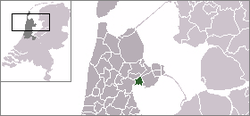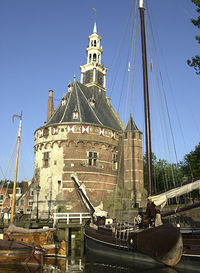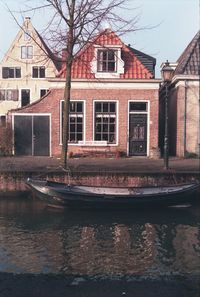Hoorn
| Hoorn | |||
|---|---|---|---|
| — Municipality — | |||
 |
|||
|
|||
 |
|||
| Coordinates: | |||
| Country | Netherlands | ||
| Province | North Holland | ||
| Area(2006) | |||
| - Total | 52.24 km2 (20.2 sq mi) | ||
| - Land | 19.31 km2 (7.5 sq mi) | ||
| - Water | 32.93 km2 (12.7 sq mi) | ||
| Population (1 August, 2009) | |||
| - Total | 70,000 | ||
| - Density | 3,625/km2 (9,388.7/sq mi) | ||
| Source: CBS, Statline. | |||
| Time zone | CET (UTC+1) | ||
| - Summer (DST) | CEST (UTC+2) | ||
| Website | www.hoorn.nl | ||


Hoorn () is a municipality and a town in the Netherlands, in the province of North Holland. It is located on the IJsselmeer, 35 kilometres north of Amsterdam, and acquired city rights in 1357. Hoorn has 70,196 inhabitants (CBS: 3 March, 2010). The area of the municipality is 52.49 km² (32.62 km² consists of water, mainly the Markermeer), and consists of the following villages and/or districts: Blokker, Hoorn, Zwaag, and parts of Bangert and De Hulk.
Cape Horn, the most southerly point of the Americas, was named after the town by Willem Schouten, who rounded it in 1616.
Contents |
History
Founded in 716, Hoorn rapidly grew to become a major harbour town. During Holland's 'Golden Age' (or 'Golden Century'), Hoorn was an important home base for the Dutch East India Company (VOC) and a very prosperous centre of trade. The Hoorn fleet plied the seven seas and returned laden with precious commodities. Exotic spices such as pepper, nutmeg, cloves, and mace were sold at vast profits. With their skill in trade and seafaring, sons of Hoorn established the town's name far and wide. Jan Pieterszoon Coen (1587-1629) is famous for his violent raids in Dutch Indies (now Indonesia), where he "founded" the city of Batavia in 1619 (now Jakarta). He has a big statue on the Rode Steen square in the center of Hoorn.
In 1618 Willem Ysbrandtsz Bontekoe (1587-1657) undertook his first and only voyage for the VOC. His story of his travel and hardship found its way into the history books when he published his adventures in 1646 under the title Journael ofte gedenckwaerdige beschrijvinge van de Oost-Indische reyse van Willem Ysbrantsz. Bontekoe van Hoorn, begrijpende veel wonderlijcke en gevaerlijcke saecken hem daer in wedervaren. In 1616, the explorer Willem Corneliszoon Schouten braved furious storms as he rounded the southernmost tip of South America. He named it Kaap Hoorn (Cape Horn) in honour of his home town.
Hoorn's fortunes declined somewhat in the eighteenth century. The prosperous trading port became little more than a sleepy fishing village on the Zuiderzee. Following the Napoleonic occupation, there was a period during which the town gradually turned its back on the sea. It developed to become the market for the entire West Frisian agricultural region. Stallholders and shopkeepers devoted themselves to trading in dairy produce and seeds. When the railway and metalled roads came to Hoorn in the late nineteenth century, the town rapidly took its rightful place as a conveniently located and readily accessible centre in the network of towns and villages which make up the province of Noord-Holland. In 1932, the Afsluitdijk, or Great Enclosing Dyke, was completed and Hoorn was no longer a seaport.
The years after the Second World War saw a period of renewed growth. At the centre of a flourishing horticultural region, Hoorn developed an extremely varied economy. During the 1960s, Hoorn was designated an 'overflow' city to relieve pressure on the overcrowded Randstad region. Thousands of people swapped their cramped little apartments in Amsterdam for a family house with garden in one of Hoorn's modern new developments.
On 26 March 2007, Hoorn celebrated 650 years as a city. In 1357 Hoorn was awarded city rights by the Count of Holland after a lump sum payment of 1500 "schilden" to the Count.
Local government
The municipal council of Hoorn consists of 35 seats, which are divided as follows:
- VVD - 6
- VOCHoorn - 5
- PvdA - 5
- Fractie Tonnaer - 5
- CDA - 3
- D66 - 3
- GroenLinks - 3
- SP - 2
- Hoornse Senioren Partij - 2
- Hoorns Belang - 1
Railway connections
Hoorn is connected to the Dutch railway network, and has two stations: Hoorn and Hoorn Kersenboogerd. Also, it is the starting point of the historical railway between Hoorn and Medemblik.
|
|||||
Twin cities
The City Of Hoorn has a twin city status with:
- Beersel, Belgium, since 1979
- Malacca Town, Malaysia, since 1989
- Příbram, Czech Rep., since 1992
Closest cities, towns and villages
 |
Lekermeer, Baarsdorpermeer | Wognum, Zwaagdijk, Zwaag | Oosterblokker, Westwoud |  |
| Bobeldijk, Spierdijk | Wijmers, Blokdijk | |||
| Scharwoude, Grosthuizen | Edam, Volendam | Schellinkhout, Lelystad |
Cities (within 100 km)
|
Towns (within 50 km)
Villages
|
Hoorn is approximately latitudinal with the towns of Norwich (England) and Berlin (Germany).
References
- Statistics are taken from the SDU Staatscourant
External links
|
|||||||||||


